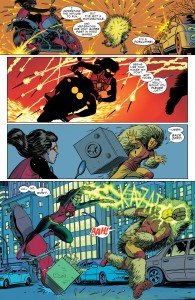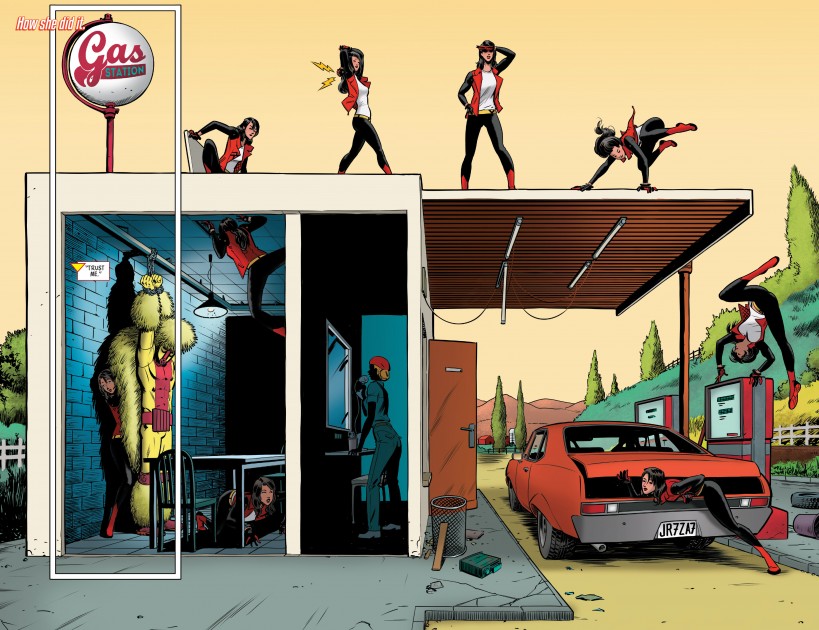Spider-Woman 5-8
Reviewed by Will Morgan 11-Jun-15
Go ahead and make the new Captain America a Hasidic Cyborg Freegan, by all means. Fancy a Thor who’s a Latina paraplegic with a knitwear fixation? Have at it! But this once, Marvel, when you’ve Got It Right – don’t mess it up!
Spider-Woman has seldom been given any respect. In fact, her genesis was the most arbitrary decision, a copyright-saving piece of business with no enthusiasm to it.
In the late 1970’s, rumour had it that a rival comics publisher had threatened to bring out a Spider-Woman title, to cash in on Spider-Man. A pre-emptive strike was required; Marvel needed to bang out a Spider-Woman of their own, and the content was irrelevant as long as the name was secured. Lo & behold, in Marvel Spotlight 32, Archie Goodwin and Sal Buscema brought us Spider-Woman, a villain-turned-hero who was, it emerged, an actual humanoid spider, courtesy of the High Evolutionary’s chromosome-crunching carryings-on. A one-off character, she was never intended to be revived, but unusually high sales on that issue meant she came back – with an adjusted, more reader-friendly origin – and in one form or another, she’s stuck around ever since.
Trouble being, despite a respectable initial 50-issue run in her own title, and numerous revivals since, no-one’s ever been really sure what to do with her. She’s been a prop in other people’s stories, an abductee, a pawn, a hostage, or, most often, a sexy siren with lots of exteriors (usually courtesy of whatever Good Girl Artist was in vogue at the time) but no inner life to speak of.
Even this latest series, spinning out of the Spider-Verse event, started off as a misfire; scripter Dennis Hopeless basically continued the Spider-Verse crossover into the new title, so half the time Spider-Woman wasn’t even the star of her own book, as Silk, Spider-Man, Spider-Gwen (ech) and other interlopers took over the series for pages at a time. Even better-than-average porn-mag swipes from Greg Land din’t make the series that much more interesting.
 But with issue 5, things took a sudden and refreshing turn. The timing, I submit, was not coincidental. Over at DC, Batgirl had recently come a full-turn around from a tense, gritty, crime drama with realistic art to a lighter-toned series with a Manga-cartoony art style, a more realistically achievable costume, and a visibly “younger” feel. This caused a lot of controversy, as DC was perceived as having “fixed” something which wasn’t “broke”, in the opinion of the reading public, as the previous Gail Simone-helmed Batgirl had a very vocal fanbase. Nevertheless, the makeover drew a huge amount of attention to the series, and, I contend, influenced Spider-Woman’s reboot.
But with issue 5, things took a sudden and refreshing turn. The timing, I submit, was not coincidental. Over at DC, Batgirl had recently come a full-turn around from a tense, gritty, crime drama with realistic art to a lighter-toned series with a Manga-cartoony art style, a more realistically achievable costume, and a visibly “younger” feel. This caused a lot of controversy, as DC was perceived as having “fixed” something which wasn’t “broke”, in the opinion of the reading public, as the previous Gail Simone-helmed Batgirl had a very vocal fanbase. Nevertheless, the makeover drew a huge amount of attention to the series, and, I contend, influenced Spider-Woman’s reboot.
At the merciful end of the interminable Spider-Verse snorefest, Jessica Drew, our heroine, turned her back on being an Avenger, and all the cosmic bollocks associated therewith,and reinvented herself as a “street-level” hero, based firmly on the ground of NYC, and with a more street-appropriate costume than her former figure-hugging skinsuits. Hopeless remained at the scripting helm, but suddenly seemed a great deal more interested in what he was doing, rather than just mopping up the leavings of another ‘event’. The art style changed also, moving away from Greg Land’s photographic tracings and into the delightful realm of Javier Rodriguez, sparser and more kinetic.
Speculating about the influences behind the makeovers of the heroines, however, doesn’t alter the results; after four months, Spider-Woman’s new direction is a critical success, whereas Batgirl’s has somehow failed to engage on anything more than a superficial level. It’s cute, it’s appealing, but it’s definitely lacking in substance.
Spider-Woman has substance aplenty. Her first few weeks as a ‘hero for the people’ having been mostly disastrous, she is approached by the Daily Bugle’s Ben Urich, who asks her to investigate matters that have been ignored or dismissed by the authorities – in this case, what appear to be the mass abductions of the significant others of second- or third-tier super-villains. The next three issues are devoted to her investigation, her recruitment of Happy-Shopper criminal ‘genius’ the Porcupine as a reluctant accomplice, and her meticulous uncovering of the truth. Much more than that can’t be said in order to prevent spoilerage, but the discovery of an actual personality for Jessica is every bit a pleasing revelation as the eventual denouement of the story arc. For possibly the first time in her history, she is more than a prop, a convenient power-set or lust-object, and it’s the getting to know her that’s the pleasure of the four issues since her relaunch.
And Javier Rodriguez’s artwork is phenomenal; spare but vivid, conveying nuances of action with a smooth choreographic flow, it’s a true joy to behold. The characters inhabit a world, they don’t just strike poses in a void.
This all makes me nervous. Why? Because with the advent of Secret Wars and all the Battleworld hoo-hah, we are threatened, once again, with an All-New Marvel Universe, with everything being different, and frankly, in the case of this and a handful of other titles (Squirrel Girl, Ms. Marvel, even the All-New Hawkeye) the last thing we need is for Marvel to play the “Everything You Knew Is A Lie!” card again.
Go ahead and make the new Captain America a Hasidic Cyborg Freegan, by all means. Fancy a Thor who’s a Latina paraplegic with a knitwear fixation? Have at it! But this once, Marvel, when you’ve actually Got It Right, would you please consider, for a change, leaving well enough alone?
Tags: Archie Goodwin, Batgirl, Dennis Hopeless, Greg Land, Javier Rodriguez, Marvel, Porcupine, Sal Buscema, Silk, Spider-Gwen, Spider-Man, Spider-Woman